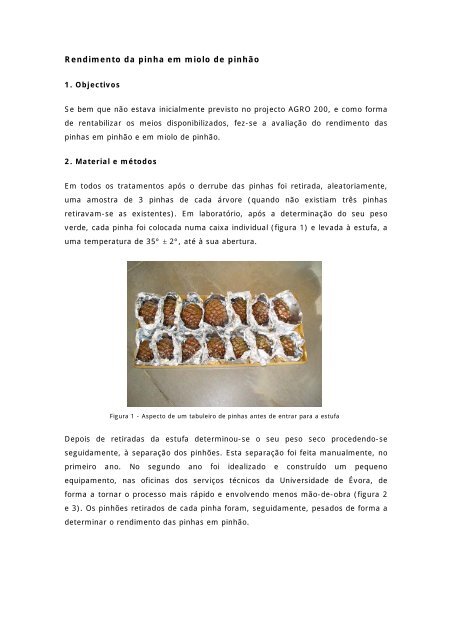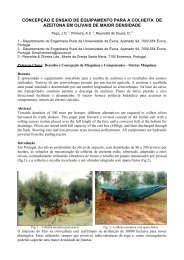Rendimento da pinha em miolo de pinhão - Universidade de Évora
Rendimento da pinha em miolo de pinhão - Universidade de Évora
Rendimento da pinha em miolo de pinhão - Universidade de Évora
Create successful ePaper yourself
Turn your PDF publications into a flip-book with our unique Google optimized e-Paper software.
<strong>Rendimento</strong> <strong>da</strong> <strong>pinha</strong> <strong>em</strong> <strong>miolo</strong> <strong>de</strong> <strong>pinhão</strong><br />
1. Objectivos<br />
Se b<strong>em</strong> que não estava inicialmente previsto no projecto AGRO 200, e como forma<br />
<strong>de</strong> rentabilizar os meios disponibilizados, fez-se a avaliação do rendimento <strong>da</strong>s<br />
<strong>pinha</strong>s <strong>em</strong> <strong>pinhão</strong> e <strong>em</strong> <strong>miolo</strong> <strong>de</strong> <strong>pinhão</strong>.<br />
2. Material e métodos<br />
Em todos os tratamentos após o <strong>de</strong>rrube <strong>da</strong>s <strong>pinha</strong>s foi retira<strong>da</strong>, aleatoriamente,<br />
uma amostra <strong>de</strong> 3 <strong>pinha</strong>s <strong>de</strong> ca<strong>da</strong> árvore (quando não existiam três <strong>pinha</strong>s<br />
retiravam-se as existentes). Em laboratório, após a <strong>de</strong>terminação do seu peso<br />
ver<strong>de</strong>, ca<strong>da</strong> <strong>pinha</strong> foi coloca<strong>da</strong> numa caixa individual (figura 1) e leva<strong>da</strong> à estufa, a<br />
uma t<strong>em</strong>peratura <strong>de</strong> 35º ± 2º, até à sua abertura.<br />
Figura 1 - Aspecto <strong>de</strong> um tabuleiro <strong>de</strong> <strong>pinha</strong>s antes <strong>de</strong> entrar para a estufa<br />
Depois <strong>de</strong> retira<strong>da</strong>s <strong>da</strong> estufa <strong>de</strong>terminou-se o seu peso seco proce<strong>de</strong>ndo-se<br />
segui<strong>da</strong>mente, à separação dos pinhões. Esta separação foi feita manualmente, no<br />
primeiro ano. No segundo ano foi i<strong>de</strong>alizado e construído um pequeno<br />
equipamento, nas oficinas dos serviços técnicos <strong>da</strong> Universi<strong>da</strong><strong>de</strong> <strong>de</strong> <strong>Évora</strong>, <strong>de</strong><br />
forma a tornar o processo mais rápido e envolvendo menos mão-<strong>de</strong>-obra (figura 2<br />
e 3). Os pinhões retirados <strong>de</strong> ca<strong>da</strong> <strong>pinha</strong> foram, segui<strong>da</strong>mente, pesados <strong>de</strong> forma a<br />
<strong>de</strong>terminar o rendimento <strong>da</strong>s <strong>pinha</strong>s <strong>em</strong> <strong>pinhão</strong>.
Figuras 2 e 3 - Processo <strong>de</strong> abertura <strong>da</strong>s <strong>pinha</strong>s, <strong>de</strong>pois <strong>de</strong> secas, com o objectivo <strong>de</strong> retirar os pinhões<br />
Os pinhões retirados <strong>de</strong> ca<strong>da</strong> <strong>pinha</strong> foram alinhados manualmente e fotografados<br />
(figuras 4 e 5). As imagens dos pinhões <strong>de</strong> ca<strong>da</strong> <strong>pinha</strong> vão permitir, <strong>de</strong>pois <strong>de</strong><br />
trata<strong>da</strong>s, conhecer as dimensões dos pinhões. Os <strong>da</strong>dos estão a ser tratados, razão<br />
pela qual não são ain<strong>da</strong> apresentados resultados.<br />
Figuras 4 e 5 – Processo <strong>de</strong> alinhamento dos pinhões e fotografia para posterior tratamento <strong>de</strong> imag<strong>em</strong><br />
Os pinhões foram <strong>de</strong>scascados manualmente. Para a maior vali<strong>da</strong><strong>de</strong> dos <strong>da</strong>dos<br />
obtidos, os pinhões <strong>de</strong> ca<strong>da</strong> <strong>pinha</strong> foram <strong>de</strong>scascados individualmente <strong>de</strong> forma a<br />
po<strong>de</strong>r ser quantificado quer o peso do <strong>miolo</strong> quer o peso <strong>da</strong>s cascas. Após o<br />
<strong>de</strong>scasque o <strong>miolo</strong> <strong>de</strong> <strong>pinhão</strong> correspon<strong>de</strong>nte a ca<strong>da</strong> <strong>pinha</strong> foi pesado para avaliar o<br />
rendimento <strong>da</strong>s <strong>pinha</strong>s <strong>em</strong> <strong>miolo</strong> <strong>de</strong> <strong>pinhão</strong> (figura 6).<br />
Figura 6 - Avaliação do peso do <strong>miolo</strong> <strong>de</strong> <strong>pinhão</strong> <strong>de</strong> ca<strong>da</strong> <strong>pinha</strong><br />
2
3. Resultados<br />
No quadro 1 apresentam-se os resultados obtidos, nos quatro povoamentos <strong>em</strong><br />
estudo, nos dois primeiros anos (campanha 2002/2003 e 2003/2004). Como se<br />
trata <strong>de</strong> um processo moroso os <strong>da</strong>dos referentes à campanha <strong>de</strong> 2004/2005 ain<strong>da</strong><br />
estão a ser avaliados. Os povoamentos 1 (Pai Sobrado), 2 (Mata <strong>de</strong> Valver<strong>de</strong>) e 3<br />
(Monte Novo) estão situados no concelho <strong>de</strong> Alcácer do Sal e o povoamento 4<br />
(Quinta <strong>de</strong> Sousa) no concelho <strong>de</strong> Ven<strong>da</strong>s Novas.<br />
Quadro 1 – Estatísticas <strong>de</strong>scritivas referentes às <strong>pinha</strong>s, pinhões e <strong>miolo</strong> <strong>de</strong> <strong>pinhão</strong><br />
Povoamento N Mínimo Média Máximo<br />
Desvio<br />
padrão<br />
1 Peso <strong>pinha</strong> ver<strong>de</strong> (g) 44.89 237.01 440.43 67.39<br />
Peso <strong>pinha</strong> seca (g) 30.19 166.13 321.59 47.88<br />
Humi<strong>da</strong><strong>de</strong> (%) 522 2.67 29.92 44.77 2.64<br />
Peso <strong>de</strong> <strong>pinhão</strong> (g) 1.94 44.19 93.85 17.48<br />
Peso <strong>de</strong> <strong>miolo</strong> (g)<br />
0.31 10.27 22.78 4.09<br />
2 Peso <strong>pinha</strong> ver<strong>de</strong> (g) 59.50 237.05 483.51 82.04<br />
Peso <strong>pinha</strong> seca (g) 41.50 164.68 333.45 55.20<br />
Humi<strong>da</strong><strong>de</strong> (%) 420 13.86 30.15 58.92 3.66<br />
Peso <strong>de</strong> <strong>pinhão</strong> (g) 5.44 43.37 96.85 18.96<br />
Peso <strong>de</strong> <strong>miolo</strong> (g)<br />
1.36 9.70 23.83 4.22<br />
3 Peso <strong>pinha</strong> ver<strong>de</strong> (g) 74.54 293.90 509.03 72.79<br />
Peso <strong>pinha</strong> seca (g) 53.21 209.50 357.03 51.72<br />
Humi<strong>da</strong><strong>de</strong> (%) 637 0.75 28.62 56.33 3.31<br />
Peso <strong>de</strong> <strong>pinhão</strong> (g) 7.18 54.26 98.54 18.20<br />
Peso <strong>de</strong> <strong>miolo</strong> (g)<br />
1.19 12.45 24.05 4.16<br />
4 Peso <strong>pinha</strong> ver<strong>de</strong> (g) 135.06 323.18 522.29 68.50<br />
Peso <strong>pinha</strong> seca (g) 97.84 229.52 375.92 47.37<br />
Humi<strong>da</strong><strong>de</strong> (%) 562 10.83 28.79 53.46 3.59<br />
Peso <strong>de</strong> <strong>pinhão</strong> (g) 22.84 72.00 124.43 17.62<br />
Peso <strong>de</strong> <strong>miolo</strong> (g)<br />
5.22 15.82 40.11 4.18<br />
No quadro 2 são apresentados os rendimentos <strong>em</strong> <strong>miolo</strong> <strong>em</strong> função <strong>de</strong> diferentes<br />
variáveis: peso <strong>de</strong> <strong>pinha</strong> ver<strong>de</strong>, peso <strong>de</strong> <strong>pinha</strong> seca e peso <strong>em</strong> s<strong>em</strong>ente.<br />
3
Quadro 2 – Estatísticas <strong>de</strong>scritivas relativas aos diferentes rendimentos<br />
Povoamento <strong>Rendimento</strong> N Mínimo Média Máximo<br />
Desvio<br />
padrão<br />
1<br />
Pinha ver<strong>de</strong> <strong>em</strong><br />
4.32 18.08 30.94 3.42<br />
2<br />
3<br />
4<br />
4. Conclusões<br />
s<strong>em</strong>ente (%)<br />
Pinha ver<strong>de</strong> <strong>em</strong> <strong>miolo</strong><br />
(%)<br />
S<strong>em</strong>ente <strong>em</strong> <strong>miolo</strong><br />
(%)<br />
Pinha ver<strong>de</strong> <strong>em</strong><br />
s<strong>em</strong>ente (%)<br />
Pinha ver<strong>de</strong> <strong>em</strong> <strong>miolo</strong><br />
(%)<br />
S<strong>em</strong>ente <strong>em</strong> <strong>miolo</strong><br />
(%)<br />
Pinha ver<strong>de</strong> <strong>em</strong><br />
s<strong>em</strong>ente (%)<br />
Pinha ver<strong>de</strong> <strong>em</strong> <strong>miolo</strong><br />
(%)<br />
S<strong>em</strong>ente <strong>em</strong> <strong>miolo</strong><br />
(%)<br />
Pinha ver<strong>de</strong> <strong>em</strong><br />
s<strong>em</strong>ente (%)<br />
Pinha ver<strong>de</strong> <strong>em</strong> <strong>miolo</strong><br />
(%)<br />
S<strong>em</strong>ente <strong>em</strong> <strong>miolo</strong><br />
522<br />
420<br />
637<br />
562<br />
0.69 4.22 7.24 0.88<br />
10.53 23.38 32.70 2.89<br />
7.28 17.68 26.31 3.00<br />
1.29 3.99 5.56 0.72<br />
8.65 22.72 29.16 3.00<br />
6.03 18.13 29.39 3.32<br />
1.21 4.19 8.64 0.88<br />
8.81 23.24 70.60 3.91<br />
8.56 22.26 29.52 2.75<br />
2.05 4.90 18.80 0.94<br />
11.91 22.08 82.68 3.52<br />
O rendimento médio <strong>de</strong> <strong>pinha</strong> ver<strong>de</strong> <strong>em</strong> <strong>miolo</strong> é s<strong>em</strong> dúvi<strong>da</strong> aquele que mais<br />
interessa aos produtores ou <strong>em</strong>preiteiros florestais. Como se po<strong>de</strong> observar no<br />
quadro 2 este rendimento médio varia entre cerca <strong>de</strong> 4 e 5%, conforme o local.<br />
Quinta <strong>de</strong> Sousa foi o povoamento on<strong>de</strong> se obteve o melhor rendimento e Mata <strong>de</strong><br />
Valver<strong>de</strong> o pior.<br />
O conhecimento do valor <strong>de</strong>ste indicador po<strong>de</strong>rá ser uma preciosa aju<strong>da</strong> quer, para<br />
os produtores, quer para os <strong>em</strong>preiteiros florestais, quando pretend<strong>em</strong> estimar a<br />
produção dos povoamentos b<strong>em</strong> como o valor económico dos mesmos.<br />
4



